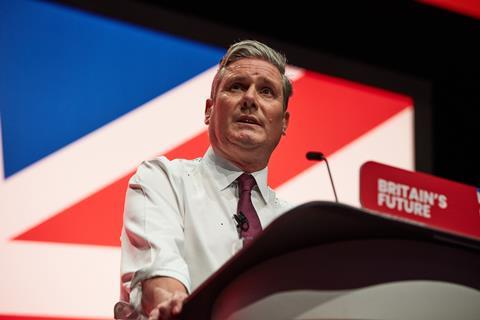Planning reforms and commitments to build new towns mostly backed by experts but lack of ambition on climate criticised
Architects and built environment organisations have broadly welcomed Labour’s election manifesto after the party confirmed its plans to build 1.5 million homes over the next five years and renew the country’s infrastructure.
The 125-page document, titled “Change”, outlined a series of sweeping planning reforms aiming to force local authorities to build more housing and reduce barriers to green energy schemes.
Billed as “a manifesto for wealth creation”, it also included a 10-year infrastructure strategy which the party said would see improved rail and road connectivity across the north of England.
> Also read: Strong rhetoric on planning but no surprises as Keir Starmer launches Labour manifesto

Alex Ely, founding director at last year’s Stirling Prize winner Mæ, said the policy prospectus contained “a lot to give us the confidence that, if all the predictions of their electoral success are correct, positive change is on the way.”
But while he welcomed Labour’s new housing targets and a commitment to build more social and affordable homes, he questioned the focus on reforming the National Planning Policy Framework (NPPF).
“We hear from nearly every government that this is the solution,” he said.
“Whilst there is always room for improvement, more than 1.1 million homes granted planning permission in England in the last decade are yet to be built.”
He argued that the more welcome details in the manifesto were Labour’s commitment to fund additional planning officers and the promise of a new generation of new towns.
“This could be a game changer that creates new places that really reflect the aspirations of our age,” he said, adding that it was an opportunity for architects to provide an alternative vision for new communities not based on the traditional styles favoured by the Conservatives.
“Now it’s time for us in the profession to give this the vision it needs if we are to avoid a regressive tail-coat wearing, historicist and populist view of the world,” he said.
> Also read: Big names warn Labour not to ‘fall for’ traditional housing design trend
We Made That co-founder Holly Lewis praised the lack of reference in the manifesto to design described as “beautiful”, a word used by the Conservatives which has been controversial because of its perceived objectivity and focus on Victorian and Georgian architecture.
“Labour’s ’first steps for change’ don’t immediately scream, ‘good for architects’, but venture a little further and you’ll find lots to be optimistic about,” she said.
“Planning reform (of course), investment in planning officers (though only 300 of them), a commitment to ‘high-quality, well-designed and sustainable homes’ (not “beautiful”, thank goodness).”
She also welcomed the party’s plans for a 10-year industrial strategy, adding that firms would “have to hope” that it will provide a more stable backdrop for the industry after a “bumpy few years”.
Simon McWhirter, deputy chief executive officer at the UK Green Building Council, also welcomed the manifesto’s pledge to reform the planning system and to make “exemplary development to be the norm”.
But he criticised the document for not going far enough on tackling climate change “head on”.
“The commitment to a doubling of funding to help upgrade the UK’s energy inefficient homes, is welcome, but falls far short of the minimum £64bn our analysis shows is needed over the next decade,” he said.
HLM Architects director Richard O’Neil said the architecture profession was likely to welcome the manifesto’s focus on economic growth and stability.
He also welcomed “critical” plans to create a new National Infrastructure and Service Transformation Authority as part of a 10-year infrastructure strategy.
But he said the manifesto could have offered more clarity around public sector infrastructure investment and the plans for the public estate. “There will be significant challenges within public service spending,” he said.
















No comments yet